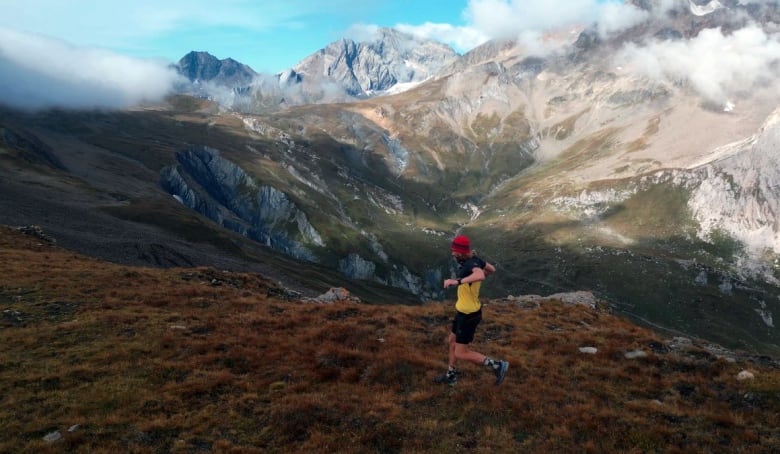It is nightfall in late June on a path blanketed with crumbled volcanic rock close to the highest of Europe’s tallest energetic volcano, Mount Etna, as Canadian David Orr takes the final crunchy steps of a run that started at 4 o’clock that morning.
His legs and arms are coated with scratches from the overgrown path he describes as “savage.”
The trail to self-discovery can take individuals to uncommon locations, however few go so far as Orr, who was on Day 1 of an virtually three-month, 3,500-kilometre run up the size of Italy. It is a journey he describes as mystical, from the eruptive Etna within the south to the snow-covered Mont Blanc (Monte Bianco in Italian) within the north.
“This morning I took the Canadian flag up there, took an Italian flag,” he says of Etna. “Then I principally slid down a thousand metres on a form of lava slide. I simply form of let myself go.”

Orr, a pc engineer from Stratford, Ont., who lives in Florence, had a start-up fail earlier this yr. Looking for a problem to assist in giving his life new which means, he determined to deepen his understanding of his adopted nation whereas drawing consideration to the extensively unknown, and in components uncared for, Sentiero Italia (SI) or Nice Italian Path.
One of many world’s nice trails
Spanning some 8,000 kilometres, the path is without doubt one of the world’s longest, traversing 16 United Nations Academic, Scientific and Cultural Group World Heritage websites and quite a few nationwide parks. Inaugurated in 1995 by the Italian Alpine Membership, the path unites the Italian peninsula beginning within the Alps, working down the boot atop the Apennines, then hopping to the islands of Sicily and Sardinia.
It’s cared for by 1000’s of volunteers who do every part from path upkeep, training and reforestation to working rescue stations and a few 21,000 beds at 750 shelters, a lot of which serve sizzling meals.
“Together with selling gradual, sustainable tourism, SI permits these strolling it to get a way of indigenous vegetation and encounter native individuals alongside the way in which,” stated Marco Garcea, a climbing information in Calabria in southern Italy who co-wrote a part of the Sentiero Italia 12-volume guidebook.
Featured VideoCanadian ultra-runner David Orr embarks on a three-month-long, 3,500-kilometre trek on one of many longest trails on this planet: the Nice Italian Path.
In 2019, the alpine membership started renovating the path, which had fallen into disrepair in stretches, particularly within the south.
“Within the north, they’ve extra well-known mountains, however in southern Italy, the paths provide a larger degree of discovery, larger contact with native tradition,” Garcea stated.
Path ‘gone to hell’ in spots
The paths within the south, he says, as soon as linked distant mountain settlements, with others utilized by inhabitants looking for firewood, accumulating grapes or grazing, together with some outdated transhumance routes for the seasonal droving of livestock.
Orr says apart from parks such because the majestic Pollino Nationwide Park that spans Calabria and Basilicata, the path in southern Italy had “principally gone to hell with Mediterranean vegetation I needed to hack my approach by means of.”
The red-and-white “SI” indicators, although, had been in wonderful situation.
“It was virtually like somebody had a sadistic sense of humour,” he stated of paths veering into farmers’ fields and thorny vegetation. “However whose fault is that this? Not nature’s. So I needed to develop a way of humour and cease combating it.”
For the primary month or so he did not encounter different hikers, apart from one couple within the Calabrian high-altitude forests who so startled him that he requested in the event that they had been misplaced.
Bigger-than-life locals
As an alternative, he got here throughout larger-than-life native individuals, foragers and mushroom hunters with wicker baskets. They peppered him with questions and invited him into their houses. One group of picnickers, who he suspected had been members of the Calabrian ‘Ndrangheta crime group, insisted he take an enormous chunk of native cheese. (“I understood it was a suggestion I couldn’t refuse,” he stated, laughing.)
He developed a friendship with a wild canine who adopted him for days and skilled a nocturnal communion with lots of of fireflies, circling the trail in stillness, like worshippers in pews.

Orr’s spouse, Kristin Sullivan — with their two younger kids in tow in a camper van for a number of weeks – and a community of pals met him on the finish of every day and arranged meals, lodging and different requirements. Funding for the run got here from Orr himself, together with donations from supporters, with an Italian sportswear firm offering gear.
“What he is doing is superb,” says Alberto Moldavi, who works at a refuge close to Prato, Tuscany, and had his image taken with “the mad Canadian” he’d heard was working the path.
“He is drawing consideration to the literal spine of Italy, the Apennine Mountain vary, which must be protected. He is practising and selling the form of tourism Italy wants.”
32-km run a ‘restoration’ day
Virtually two months in, on Day 56, Orr emerged from the woods for dinner on the Tuscan refuge. He’d simply accomplished a 65-kilometre day adopted by a 32-kilometre day of “restoration.”
His hair a wild mess and his beard thick, Orr stated he’d confronted some agonizing challenges.
He’d harm his quads and Achilles tendons early on, forcing him to decelerate and run longer. Carrying water in remoted areas proved too onerous, so he opted for lengthy stretches of dehydration. He estimates that 5 per cent of distance run was backtracking after getting misplaced.
However working the trail, he stated, allowed him to expertise highly effective transitional moments, like rising from the depopulated south-central area of Molise, with its wind-swept yellow-brown palette giving technique to the extra populated Abruzzo and the north of Italy.
“It was virtually like a portal into the trendy world, with individuals sporting fluorescent sports activities gear,” he stated. “And on bikes!”
‘Be motherly with your self’
Orr prefers ultra-running to marathons as a result of the main target is not on time, however endurance, which helps settle his thoughts and block round pondering, a trademark of despair he is struggled with at occasions.
“You are going such lengthy distances that it’s important to examine in together with your thoughts and physique, to be motherly with your self,” he stated. “I additionally actually benefit from the individuals who do it, who’ve steely minds and are optimists. It’s important to be, to do a 100-kilometre race.”
Virtually three months after setting off, Orr confronted his remaining problem — making it to the highest of snow-covered Mont Blanc, Europe’s highest mountain, straddling the Italian-French border.
He’d deliberate to take three days to run up the summit to assist acclimatize to the 4,800-metre top. However the refuges had been booked up. So he did it in at some point, working 73 kilometres by means of Italy’s Valle d’Aoste area, crossing into France at 2,300 metres to entry the height, then traversing a 100-metre “loss of life ridge” with the danger of falling boulders.
“That was a monstrous day,” he stated.
At 3 a.m., on the eighty fifth day, he accomplished his 3,500-kilometre journey.
Now again in Florence, he says he is proud he, with the assistance of his spouse and others, was in a position to pull it off.
“I felt like I used to be in a long-term relationship with the path and it demanded faithfulness to it,” he stated.
He is now taking care of his kids to present his spouse time to deal with her profession after three months of being a single mum or dad.
The problem that awaits him is on a regular basis life.
“The trick is as soon as you’ve got achieved it to make the remainder of your life an equally mythic journey. And that is not that easy.”


